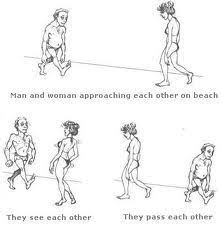Animating the Differences in Gender.
Taking in the perspective
Studies of human locomotion have found
that male and female walkers differ in terms of lateral body sway, with
males tending
to swing their shoulders from side to side more
than their hips, and females tending to swing their hips more than their
shoulders.
Experiments demonstrate that people can identify the gender of the figure in a biological motion
display
very reliably when the display contains
gender-specific lateral body sway.
Sensitivity to gender is high even
for displays
containing only a fraction of a step cycle. This dominates structural cues based on torso shape
(`centre-of-moment')
when the cues are set in opposition. It is based on gender-specific differences in the velocity of shoulder and hip
dots,
not by positional differences in shoulder and hip
dots during the step cycle.

- Men take up more space with their arms and legs stretched out from their bodies,
- while women do the opposite.
- Men gesture away from their bodies, while women gesture toward theirs.
- Men assumes more reclined position and lean backward when listening,
- while women assume more forward positions, especially when listening.
- Men are not as sensitive to the communication cues of others.
- Women have greater acuity toward nonverbal cues.
- Men tend to approach women more closely in terms of their personal space.
Body Language
Men
- Desire space
- Tend to be withdrawn rather than engaged bodily
- Do not touch, unless with same gender in playful aggression
- Tend to move around and shift body when conversation is uncomfortable
Women
- Body alignment, face the other person
- Use more hand gestures
- Use more bodily contact
- Sat relatively still
Facial Expression
Men
- Don’t use a lot of eye contact
- Use more head motion
- Conceal and control facial displays
- Smile less
Women
- Use eye to eye contact
- Use less head motion than men
- Tend to express emotion through facial expression
- Smile more, and have been noticed by body language specialists to smile when feeling threatened.
Speech
Men
- Use talk to assert their independence.
- Sitting and talking is not an essential part of friendship
- Hear talk of problems as a request for advice or help.
- Give orders as a way of gaining social status.
- Use more small talk.
Women
- Use conversation to negotiate closeness and intimacy.
- Talking is the essence of intimacy; sitting and talking means friendship.
- Speaking about problems is the essence of connection.
- Rule by consensus; get the input of others to make a decision.
- Go in-depth on a topic.
Thanks to:
http://www.datehookup.com/content-gender-differences-in-communication.htm
http://rspb.royalsocietypublishing.org/content/258/1353/273
http://www.examiner.com/article/sex-linked-men-s-vs-women-s-body-language-flirting |

No comments:
Post a Comment